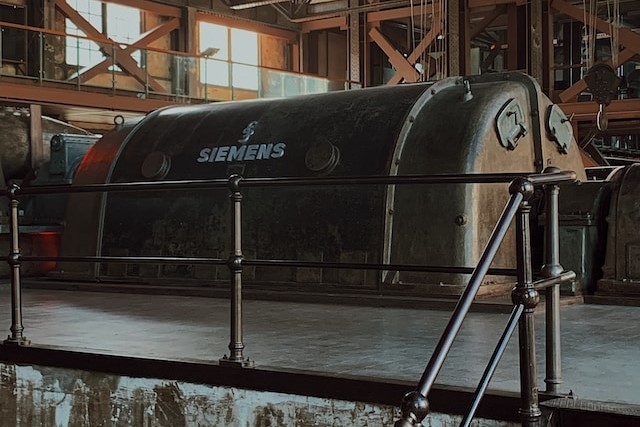Before we dive deep into the PESTEL analysis, let’s get the business overview of Siemens. Siemens AG is a multinational conglomerate based in Munich, Germany. Founded in 1847 by Werner von Siemens, it has grown into one of the world’s most extensive energy-efficient technologies and engineering solutions producers. Siemens has a diversified portfolio across several sectors, including industry, energy, healthcare, and infrastructure.
Key Business Segments:
- Digital Industries: This segment offers a comprehensive range of software, automation technology, and services for the manufacturing sector. With products for computer-aided design, manufacturing, and product lifecycle management, Siemens is a leader in the digital transformation of industries.
- Smart Infrastructure: Siemens offers technologies for the electrification of buildings, energy storage solutions, building automation, and fire safety equipment, all of which contribute to creating smart buildings and distributed energy systems.
- Gas and Power: This sector focuses on energy production. Siemens offers turbines for power generation, compressors, transmission solutions, and more. They’ve been involved in sustainable energy solutions, including wind turbines and power grid solutions.
- Mobility: Siemens is involved in transportation and logistics, offering solutions for rail transportation, including trains, rail automation, and electrification systems. They also provide traffic and transportation systems for intermodal mobility.
- Siemens Healthineers: This subsidiary is a leader in medical technology, providing a broad range of products in imaging, diagnostics, and laboratory diagnostics.
- Siemens Financial Services (SFS): This segment provides financial solutions, particularly for Siemens’ B2B endeavors, aiding clients in procuring Siemens technologies and services.
- Siemens Gamesa Renewable Energy: A subsidiary focused on sustainable energy, particularly wind power. They manufacture wind turbines and provide related services.
- Siemens Energy: Spun off in 2020, this standalone company focuses on the entire energy market, ranging from design and production to services for energy systems.
Financial Performance 2022: Siemens generated a revenue of 89bn Euros in FY22 with a net income of 4.4bn Euros.
Here is the PESTEL analysis of Siemens
A PESTEL analysis is a strategic management framework used to examine the external macro-environmental factors that can impact an organization or industry. The acronym PESTEL stands for:
- Political factors: Relate to government policies, regulations, political stability, and other political forces that may impact the business environment.
- Economic factors: Deal with economic conditions and trends affecting an organization’s operations, profitability, and growth.
- Sociocultural factors: Relate to social and cultural aspects that may influence consumer preferences, lifestyles, demographics, and market trends.
- Technological factors: Deal with developing and applying new technologies, innovations, and trends that can impact an industry or organization.
- Environmental factors: Relate to ecological and environmental concerns that may affect an organization’s operations and decision-making.
- Legal factors: Refer to the laws and regulations that govern businesses and industries.
In this article, we will do a PESTEL Analysis of Siemens.
PESTEL Analysis Framework: Explained with Examples
Political
- International Trade Policies: As a global conglomerate, Siemens’ operations can be influenced by international trade policies and tariffs. Changes in these policies, such as trade restrictions or tariffs, can affect Siemens’ import and export activities, impacting costs and revenues.
- Geopolitical Stability: Siemens operates in numerous countries, and geopolitical tensions or instabilities can affect its business operations. Conflicts, coups, or diplomatic tensions in regions where Siemens has significant business interests can pose risks.
- Government Regulations and Incentives: Different countries have regulations that can impact Siemens’ sectors, from energy to healthcare. Moreover, government incentives for renewable energy, digitization, or infrastructure development can benefit Siemens’ business segments.
- Public Infrastructure Projects: Siemens often engages in large public infrastructure projects. Governments’ political willingness or reluctance to invest in infrastructure, especially transportation, energy, and healthcare, can influence Siemens’ opportunities.
- Political Shifts: A change in ruling parties or political leadership can influence public policies and regulations. Shifts toward more environmentally friendly governments can benefit Siemens’ renewable energy sector, whereas other shifts might impact Siemens differently.
- Tax Policies: Corporate tax rates, policies, and incentives for R&D can affect Siemens’ investment decisions and profitability in different countries.
- Energy Policies: Given Siemens’ involvement in energy production and solutions, national energy policies, particularly around renewable energy, nuclear power, and fossil fuels, are paramount.
- Bilateral and Multilateral Agreements: Agreements between countries (like the EU’s collective policies or US-China trade agreements) can affect Siemens’ operations, trade activities, and growth strategies.
Economic
- Global Economic Conditions: Siemens, a multinational conglomerate, is influenced by the overall health of the worldwide economy. Economic downturns, recessions, or slowdowns can reduce demand for Siemens’ products and services.
- Exchange Rates: Fluctuations in currency exchange rates can impact Siemens’ revenues and profitability, especially given its extensive international operations. Currency devaluation or appreciation can affect the company’s competitiveness and profit margins.
- Interest Rates: Changes in interest rates by central banks can influence Siemens’ financing costs, especially for major infrastructure projects that require significant capital expenditure.
- Economic Policies: Policies related to monetary and fiscal stimulus, tax incentives, subsidies, or economic reforms can directly affect Siemens’ operational environment.
- Investment in Infrastructure: Governments’ economic focus on infrastructure development can increase opportunities for Siemens, especially in its mobility and energy divisions.
- Supply Chain Costs: Economic factors can impact the cost of raw materials and components Siemens relies upon, affecting the overall cost structure of their products.
- Industry Cycles: Industries like energy and infrastructure have their economic cycles. The stage of the cycle (growth, maturity, or decline) can determine the demand for Siemens’ solutions in these segments.
Sociocultural
- Health Consciousness: As Siemens has a strong foothold in the healthcare sector with medical imaging and laboratory diagnostics, evolving attitudes toward health and wellness can influence demand for its products and services.
- Sustainability and Environmental Awareness: Modern consumers are increasingly concerned about the environment. With its focus on sustainable solutions, especially in renewable energy, Siemens can leverage this shift in societal values.
- Attitudes Toward Technology: The general public’s trust and acceptance of technology, especially in areas like AI, automation, and digital solutions, can impact Siemens’ product development and adoption rates.
- Education and Skill Development: The emphasis on STEM (Science, Technology, Engineering, and Mathematics) education in different societies can influence the talent pool available for Siemens.
- Safety and Security Concerns: In the wake of global challenges, societies are highly emphasizing safety and security. With its infrastructure and technology solutions, Siemens can play a role in addressing these concerns.
Technological
- Innovation and R&D: Siemens is known for its commitment to innovation and research & development. As technology evolves, Siemens must continually invest in R&D to stay competitive and offer state-of-the-art solutions.
- Digitalization and Industry 4.0: The rise of the fourth industrial revolution or Industry 4.0—with smart manufacturing, IoT (Internet of Things), and AI (Artificial Intelligence)—plays into Siemens’ strengths, as they offer solutions that help industries become more digitalized and automated.
- Medical Technology Advancements: Given Siemens Healthineers’ role in the company’s portfolio, advancements in medical imaging, diagnostics, and health IT solutions play a crucial part in its success.
- Renewable Energy Technologies: Siemens Energy offers solutions in the renewable sector. Technological advancements in wind, solar, and other green energy sources directly impact the company’s product offerings and market dynamics.
- Cybersecurity: As industries become more interconnected and digitalized, the importance of cybersecurity increases. Siemens needs to ensure that its products and solutions are secure and can address potential cyber threats.
- Smart Infrastructure Solutions: With urbanization and the push for smarter cities, technology solutions for intelligent buildings, transportation systems, and grid technologies have become vital. With its focus on smart infrastructure, Siemens is well-positioned to leverage these trends.
- Cloud and Data Analytics: The rise of cloud computing and big data analytics offers Siemens opportunities, especially in managing and analyzing data from its industrial and healthcare solutions.
- Electrification of Transport: Advancements in electric and autonomous vehicles can impact Siemens’ Mobility division, which offers rail and road traffic solutions.
- 5G and Connectivity: The rollout of 5G networks can influence Siemens’ digital industries segment, enabling more efficient communication and data transfer for industrial applications.
- Supply Chain Digitalization: As supply chains become more digital and interconnected, Siemens can leverage technology to enhance efficiency, reduce costs, and better manage its global operations.
Environmental
- Climate Change: With growing awareness of global warming and climate change, demand for sustainable and energy-efficient solutions is increasing. With its emphasis on renewable energy technologies and energy-efficient infrastructure, Siemens stands to benefit from this trend.
- Emissions Standards: Regulations to reduce greenhouse gas emissions can influence Siemens’ products, especially in their energy division. The company has opportunities to offer low-emission and emission-free technologies.
- Resource Scarcity: The increasing scarcity of natural resources emphasizes the need for efficient and sustainable technologies. Siemens can capitalize on this through their resource-efficient processes and products.
- Sustainable Product Lifecycle: From design and manufacturing to disposal, there’s a push for products to have a sustainable lifecycle. Siemens has been focusing on creating products that consume less energy and are recyclable at the end of their life.
- Renewable Energy Transition: As the global community shifts away from fossil fuels, the demand for renewable energy solutions rises. Siemens Energy’s expertise in wind, hydro, and other renewable technologies positions the company well in this sector.
- Green Building Solutions: With the increasing demand for sustainable buildings, Siemens can leverage its smart infrastructure division to offer energy-efficient building solutions.
- Sustainable Supply Chain: Ensuring the entire supply chain is sustainable, from raw material sourcing to product delivery, is becoming crucial. Siemens must evaluate its suppliers and partners based on their environmental practices.
Legal
- Regulatory Compliance: Siemens operates in various countries, each with its regulatory landscape. Complying with local laws, whether related to business operations, taxes, or labor, is essential.
- Intellectual Property Laws: As a technology-driven company, protecting its innovations through patents, trademarks, and copyrights is crucial for Siemens. Ensuring IP protection and avoiding infringement is key.
- Employment Laws: Adhering to labor laws, workers’ rights, and fair employment practices in every country they operate in is fundamental to Siemens’ operations.
- Health and Safety Regulations: Siemens, especially in its industrial sectors, must comply with health and safety standards, ensuring the well-being of its employees and customers.
- Trade and Tariff Regulations: Given Siemens’ global footprint, changes in trade laws, tariffs, and import/export regulations can influence its supply chain and market accessibility.
- Product and Quality Standards: Certain products of Siemens, especially in the medical and energy sectors, must meet specific quality and safety standards before being sold in various markets.
- Contract and Agreement Laws: Siemens engages in various contracts, be it with suppliers, partners, or customers. Ensuring these contracts are legally sound and protect Siemens’ interests is essential.
- Antitrust and Competition Laws: Given Siemens’ significant market presence in various sectors, it must be mindful of antitrust and competition laws to prevent monopolistic practices and ensure fair competition.











